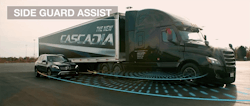When Doug Donaldson, chief engineer for steering and product innovation at WABCO Americas, stepped to the podium during the standing-room-only safety systems seminar at the recent Technology & Maintenance Council (TMC) event in Atlanta, he was in the unenviable position of being the fifth speaker out of five.
Doubling down, he began his talk by quoting numbers, percentages and financials, a dangerous strategy when you’re the last 15 minutes out of 75 and folks are getting a bit antsy.
He knew what he was doing because he knew his audience.
- This is the fifth and final part in a continuing Fleet Owner safety systems series. Read Part 1, Part 2 , Part 3 and Part 4.
“Data from the Insurance Institute for Highway Safety indicates that for the automotive industry as a whole, there were 37,113 fatalities the same year. The total cost of all fatalities and accidents was $44 billion in 2013, slightly out of date but still a very relevant data point.”
That last point surely perked up attendee ears.
“So how do you take those statistics and distill and prioritize the opportunities to assist the driver?” posed Donaldson.
Answering his own question, he said it was a combination of more new technology along with drivers not being overwhelmed by it. He then presented how certain accidents can be addressed with the technologies of today and what’s on the horizon.
“Many pre-crash scenarios essentially result in a collision,” he said. “One is road edge departure without prior vehicle movement. What sensing technology do I have to mitigate that? You can start off with lane departure warning and move to lane keep assist.
“Another point… lead vehicle stopped. This is where the forward collision alert and collision mitigating braking come in. It’s another area you can quantify how many accidents there are and prioritize your resources.
“By correlating this data to the current sensing and control technology you can create a roadmap and continually improve and develop the vehicle safety technology.”
Donaldson showed a visual that bullet-pointed where things are going in 2019 and beyond. They included:
- Multi-lane autonomous emergency braking
- Highway departure braking
- Faster reacting autonomous emergency braking
- Automated parking/Anti-rollaway
- Retrofit existing truck fleet
“It’s continuing on the path to added driver assistance and safety,” he noted.
Addressing driver concerns that too much technology without their input could be overwhelming, Donaldson stressed the importance of not overwhelming drivers.
“Let’s take lane departure warning to start with,” he began. “That technology with cameras started getting released around 2009, and the sensors continue to evolve so you can do better lane detection, which allows you to do better and better driver assistance.
“So what’s the next technology for lane departure warning? That’s where you merge to lane keep assist. It essentially starts to actively assist the driver. The system becomes less and less intrusive and more and more driver-intuitive. That’s when drivers start to appreciate the system.”
Donaldson said even more impressive safety systems are getting closer to reality.
“Side blind spot detection, and intersection alert, for vehicles coming toward you,” he said. “Then it will evolve it into platooning, enhancing the communication between two vehicles, which will allow drivers to control the vehicles with much more precision. The key is to continually keep developing the technology.”
About the Author
Michael Catarevas
Michael Catarevas is a former managing editor at FleetOwner. He wrote for the publication from 2017 to 2020.

